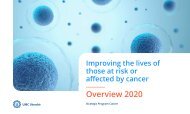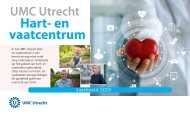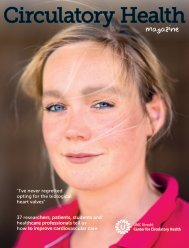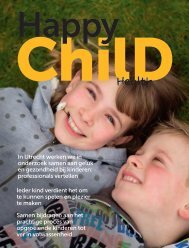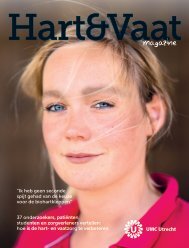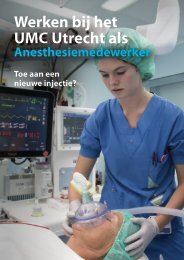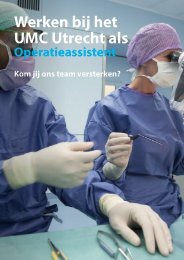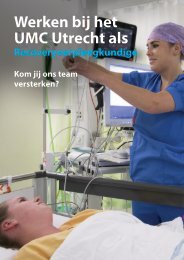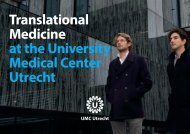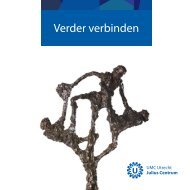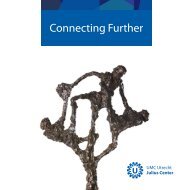Child research
Create successful ePaper yourself
Turn your PDF publications into a flip-book with our unique Google optimized e-Paper software.
STRATEGIC THEMES: INTERDISCIPLINARITY<br />
Empowering the entire family<br />
Center of Excellence for Rehabilitation Medicine<br />
(De Hoogstraat Rehabilitation)<br />
Advances in medical technology, diagnosis and treatment have increased the life expectancy<br />
of various childhood disorders. Pediatric rehabilitation aims to optimize autonomy, selfmanagement<br />
and participation of children with developmental disabilities and their families.<br />
Our interdisciplinary program focuses on developmental trajectories, identification of children<br />
at risk for physical and mental health problems and interventions to mitigate those risks.<br />
Because families are central in the lives and development of children, we also focus on family<br />
empowerment.<br />
Patients and families are involved throughout our <strong>research</strong> process, from idea to<br />
implementation, and we have a strong collaboration with patient organizations, including<br />
Cerebral Palsy Netherlands (CP Nederland; formerly known as BOSK). A good example is our<br />
study on sleep, nutrition and physical activity of children with Brain Based Developmental<br />
Disabilities. Together with Neonatology, we’ve developed clinical care pathways to guide<br />
clinicians with assessment and early identification of problems in these areas, based on<br />
systematic data collection. We seek to understand the quantity and quality of sleep and its<br />
relationship with development. In partnership with parents, we’re developing a support<br />
program, including an instructional video and online knowledge translation resources, to<br />
educate and empower families so they can support the development and health of their child.<br />
mketela2@umcutrecht.nl<br />
We collaborate with<br />
patients and families in all<br />
stages of <strong>research</strong>.<br />
- Marjolijn Ketelaar<br />
<br />
Marjolijn Ketelaar,<br />
PhD focuses on the<br />
development of children<br />
with developmental<br />
disabilities, and<br />
empowerment of<br />
families to optimize<br />
autonomy and<br />
participation.<br />
Novel insights into cancer immunotherapy<br />
mboes@umcutrecht.nl<br />
Marianne Boes,<br />
PhD focuses on<br />
immunodeficiencies<br />
and immune activation<br />
with a special<br />
interest in immune<br />
checkpoints and<br />
developing immunotherapy<br />
for cancer<br />
patients.<br />
Immunotherapy based on checkpoint blocking antibodies (anti CTLA4, anti PD-1) has<br />
revolutionized treatment for patients suffering from well-responding cancers such as<br />
melanoma and non-small cell lung cancer, which are tumors with acquired mutational loads.<br />
Neuroblastoma accounts for 15% of childhood cancer mortality, yet susceptibility to<br />
checkpoint blockade-based immunotherapy is not evident. Because the level of expression<br />
of major histocompatibility (MHC) Class-I molecules is low, neuroblastoma tumors evade a<br />
major immune defense strategy based on MHC-restricted cytotoxic T cells. In our opinion,<br />
induction of MHC-I membrane expression is prerequisite for optimal efficacy of T-cell therapy<br />
in neuroblastoma and should be incorporated into treatment regimens.<br />
My team initiated an interdisciplinary collaboration with colleagues at the Netherlands<br />
Cancer institute to screen for targets that upregulate MHC-I display at the neuroblastoma cell<br />
surface, yielding TNIP1 and N4BP1. Validation experiments in neuroblastoma revealed<br />
increased MHC-I antigen presentation capacity and induced recognition by neuroblastoma<br />
tumor-antigen specific T-cells. Supporting our findings, patients expressing high levels of<br />
TNIP1 and N4BP1 in neuroblastoma have lowered MHC-I tumor surface display and have<br />
worse survival probability. Use of these targets in therapy has the potential to augment<br />
current treatments in innovative ways that will improve clinical outcomes for neuroblastoma<br />
cancer patients.<br />
UMC Utrecht - <strong>Child</strong> <strong>research</strong> 37



